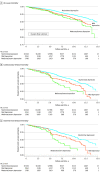Depressive Symptoms and Mortality Among US Adults
- PMID: 37812418
- PMCID: PMC10562940
- DOI: 10.1001/jamanetworkopen.2023.37011
Depressive Symptoms and Mortality Among US Adults
Abstract
Importance: Depression is a common mental health disorder in the US. Depressive symptoms have been associated with increased cardiovascular disease incidence and mortality, but studies have largely focused on narrow population subgroups.
Objective: To examine the association between depressive symptoms and mortality in a large, diverse, nationally representative sample of US adults, and to examine how lifestyle factors mediate this association.
Design, setting, and participants: This was a prospective cohort study of a nationally representative sample of US adults using National Health and Nutrition Examination Survey 2005 to 2018 data linked with the National Death Index through 2019 for adults aged 20 years and older. Data were analyzed between March 1 and May 26, 2023.
Main outcomes and measures: All-cause, cardiovascular disease, and ischemic heart disease mortality. Depressive symptoms were defined by Patient Health Questionnaire-9 scores and were categorized as none or minimal, mild, and moderate to severe. Secondarily, we assessed degree of mediation by lifestyle factors.
Results: A total of 23 694 participants were included (unweighted n = 11 862 male [weighted 49.8%]; mean [SE] age, 44.7 [0.24] years). Prevalences of mild and moderate to severe depression were 14.9% and 7.2%, respectively. For all-cause mortality, hazard ratios were 1.35 (95% CI, 1.07-1.72) for mild depressive symptoms vs none and 1.62 (95% CI, 1.24-2.12) for moderate to severe depressive symptoms vs none. The corresponding hazard ratios were 1.49 (95% CI, 1.11-2.00) and 1.79 (95% CI, 1.22-2.62) for cardiovascular disease mortality and 0.96 (95% CI, 0.58-1.60) and 2.21 (95% CI, 1.24-3.91) for ischemic heart disease mortality. The associations were largely consistent across subgroups. Approximately 11.0% to 16.1% of the associations between depression and mortality could be explained by lifestyle factors. Feeling tired or having little energy, poor appetite or overeating, and having little interest in doing things were independently associated with all-cause and cardiovascular disease mortality but not with ischemic heart disease mortality.
Conclusions and relevance: In this prospective cohort study of a nationally representative sample of US adults, there was a graded positive association between depressive symptoms and mortality. Public health efforts to improve awareness and treatment of depression and associated risk factors could support a comprehensive, nationwide strategy to reduce the burden of depression.
Conflict of interest statement
Figures
References
-
- National Institute of Mental Health . Mental Health information statistics. Accessed May 22, 2023. https://www.nimh.nih.gov/health/statistics/major-depression
-
- Smolderen KG, Buchanan DM, Gosch K, et al. . Depression treatment and 1-year mortality after acute myocardial infarction: insights from the TRIUMPH registry (Translational Research Investigating Underlying Disparities in Acute Myocardial Infarction Patients’ Health Status). Circulation. 2017;135(18):1681-1689. doi:10.1161/CIRCULATIONAHA.116.025140 - DOI - PMC - PubMed
-
- Hughes MF, Patterson CC, Appleton KM, et al. . The predictive value of depressive symptoms for all-cause mortality: findings from the PRIME Belfast study examining the role of inflammation and cardiovascular risk markers. Psychosom Med. 2016;78(4):401-411. doi:10.1097/PSY.0000000000000289 - DOI - PubMed
MeSH terms
LinkOut - more resources
Full Text Sources
Medical


